-
Welcome back Guest! Did you know you can mentor other members here at H-M? If not, please check out our Relaunch of Hobby Machinist Mentoring Program!
You are using an out of date browser. It may not display this or other websites correctly.
You should upgrade or use an alternative browser.
You should upgrade or use an alternative browser.
Buffalo No. 15 Drill Press Restoration
- Thread starter wildo
- Start date
- Joined
- Dec 7, 2015
- Messages
- 519
What's the diameter of the spindle?
You could always send me the spindle, I could tig it up
Sorry for the late response; I had a super busy weekend out of town. That's a really generous offer that I may have to take you up on! I haven't measured the spindle yet, but I believe it's likely a Jacobs 33 taper. Long end: 0.6240 Short end: 0.5605 This seems about right because I think the spindle is probably around .625 overall. I plan on getting all the parts cleaned up in my new parts washer tonight. Then I'll get a better look at it to see if it can be cleaned up with a file or not. Thanks! I'll keep in touch...
- Joined
- Dec 7, 2015
- Messages
- 519
A bit more progress. I now have the machine completely disassembled. The post was a real chore to get out of the base. The bottom of the post tube had been mushroomed over from someone hammering on it, and this mushrooming wouldn't pass the machined collar in the base. I had to turn it upside down and dremel off the hammered metal. This allowed the post to pass through the base for removal. I then cleaned up the bottom (and top- for the same reason) on the bandsaw. I only sacrificed about 1/2" of the overall length of the post.
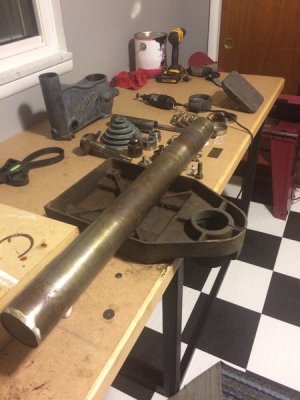
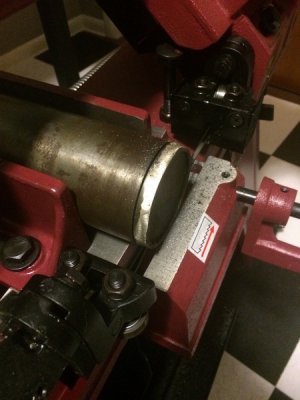
I still have the base and the table to scrub down, but otherwise everything has been degreased and wire brushed. There's still plenty of cleanup to do on the moving parts (like the spindle & quill) but essentially it's all downhill from here!
New bearings arrive today. The new motor (a 1HP 3Ph Baldor) was purchased today. I'm hoping to make it to Tractor Supply tonight to pick up the paint. The only thing left to buy is the VFD.
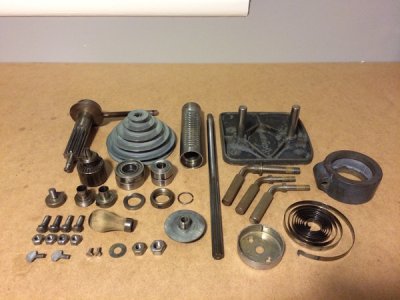
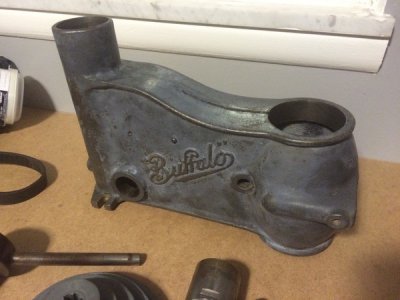
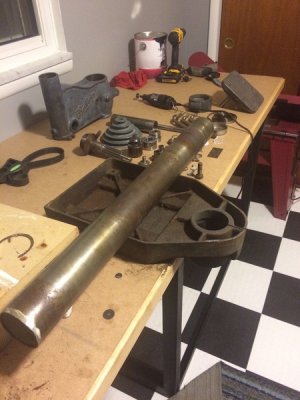
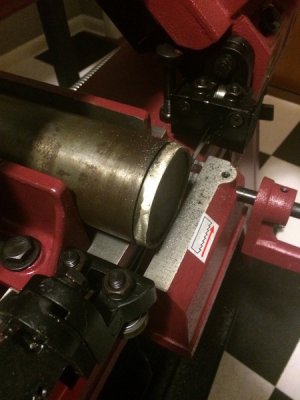
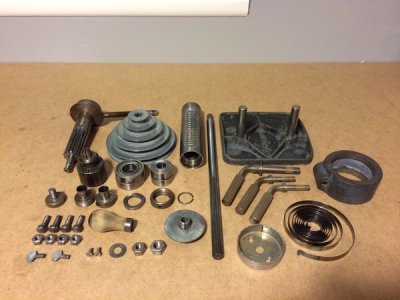
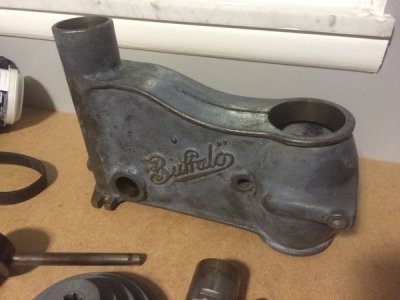
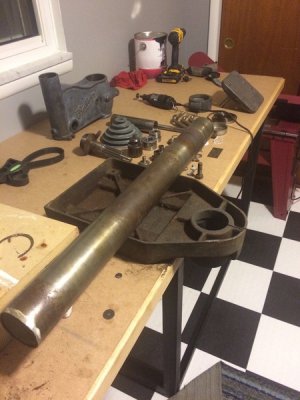
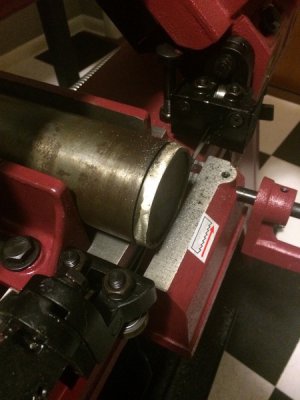
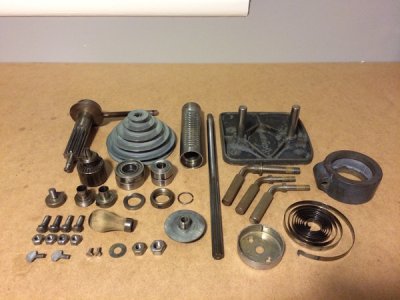
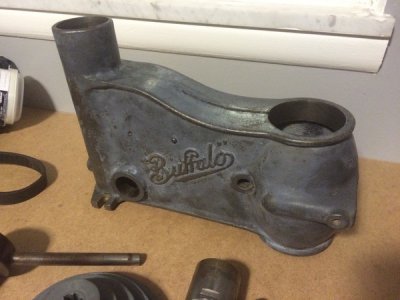
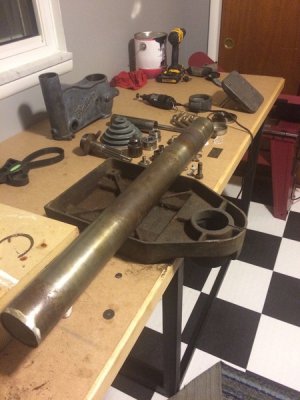
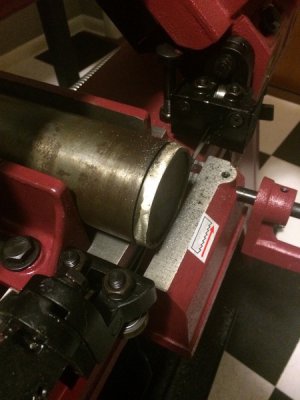
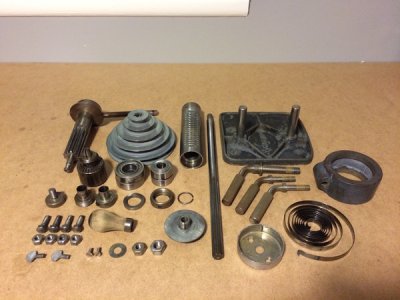
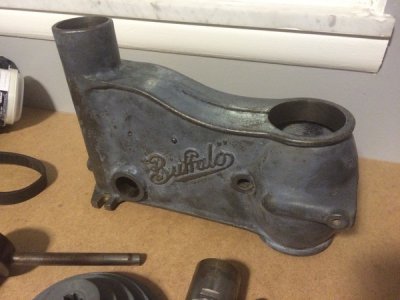
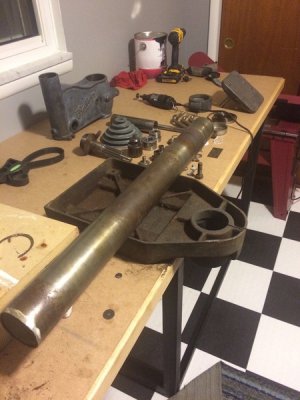
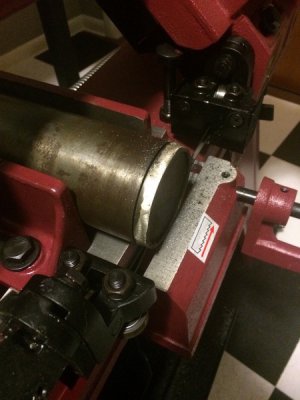
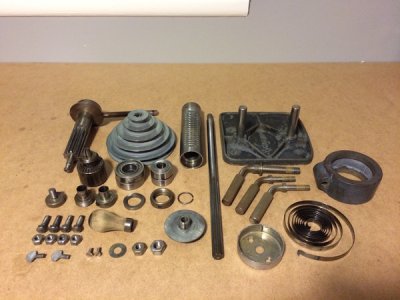
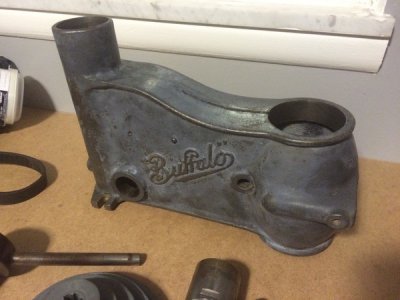
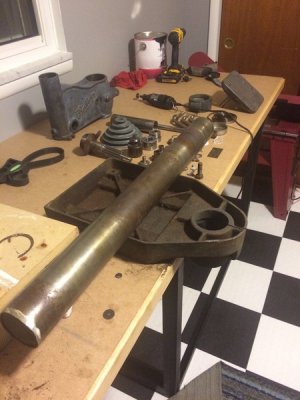
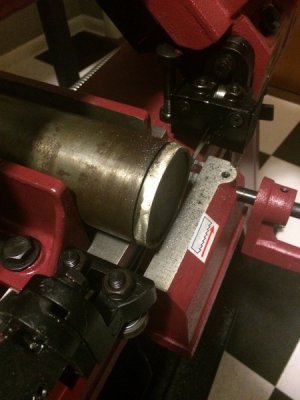
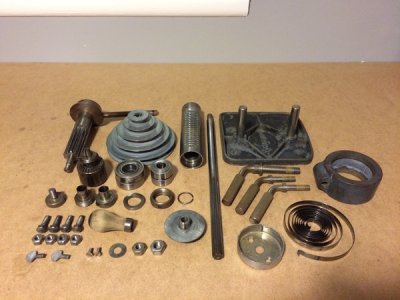
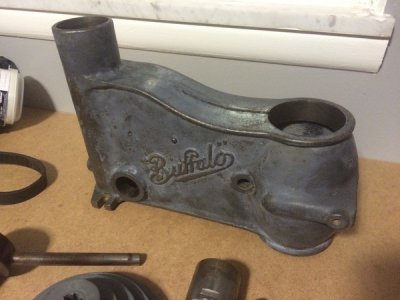


I still have the base and the table to scrub down, but otherwise everything has been degreased and wire brushed. There's still plenty of cleanup to do on the moving parts (like the spindle & quill) but essentially it's all downhill from here!
New bearings arrive today. The new motor (a 1HP 3Ph Baldor) was purchased today. I'm hoping to make it to Tractor Supply tonight to pick up the paint. The only thing left to buy is the VFD.






















- Joined
- Dec 7, 2015
- Messages
- 519
By the way- I still can't find a serial number. If anyone knows where it's located- I'd sure appreciate the info. I did notice that there are two screw nails on the right side of the head that would have assumedly held a nameplate of some sort. I have no idea what was here originally. Beyond that, I don't see anywhere where a serial number would be.
- Joined
- Dec 7, 2015
- Messages
- 519
Lookin good, did you finger out what your gonna do with that mucked up spindle taper?
No I didn't. Here's my dilemma- if you haven't noticed, I'm totally new to this. I've been making things my entire life. Lots of wood working, plenty of hobby arc welding and metal working projects. Plenty of wood turning. Carpentry, electrical, etc, etc. BUT- machining is new to me. I don't know if turning down that taper would be a good first turning project or not. I'm sure I have *plenty* of learning to do in order to get good surface finishes and all. And in the meantime- it sure would be nice to have a working drill press.
So what I suspect I'll do at this point is clean it up the best as possible by knocking down the high spots with a file and as carefully as possible clean it up with a light touch of emery cloth (realizing this does take off material). I mean- the chuck female taper is as jacked up as the shaft, so... still not sure what to do about that. I'll get it serviceable until I have more skill/experience and then take someone (you, perhaps) up on the offer to fix it up correctly. I think that seems like a good approach given my experience level. I'm not exactly shying away from turning down the weld buildup, I'm just accepting that my initial skill level probably doesn't lend to this being a good first turning project.
- Joined
- Jun 15, 2013
- Messages
- 1,199
Get a new chuck, and I'm not sure you should cut that taper, it needs to be perfect, u kinda need to have the proper tooling to set up for that job, seems to me it's going to have alot of runout if you don't fix it, which means you can't use small drill bits, it will make them break. But also with all drill bits, it means that your holes won't be on size, and to know how much run out you have you kinda need to put it all back together and see, and if it's a large amount, take it all apart again lol
- Joined
- Nov 14, 2014
- Messages
- 851
I wouldn't touch the spindle until you have some significant experience on the lathe. Mostly because spare parts for these old machines are mostly non existent- if you mess it up you will need to machine an entirely new replacement. A big job to get exactly right. You could take the spindle out to a shop and have it repaired, or put it back together as is and see how it runs.
Regarding welding up the taper and recutting it, likely any welding that occurs will distort the overall piece, possibly twisting the axis out of alignment- resulting in worse run out at the end causing outmod round holes when drilling, and broken drill bits. So again, interview a shop or two and see what they say.
Regarding your table. It looks to be in remarkable good shape. You could leave it alone, just lightly clean off any rust and oxidation and be good to go. Or there are several methods for repairing dings, such as drilling out the hole and driving an interference fit steel rod into the newly drilled hole. Cut and mill or file flush. Reportedly this method gives good results with almost no noticeable repair being visible on the surface of the table.
regarding welding your table, I would only do so if you find a welder with actual experience welding cast iron. you need to fill up the holes with similar cast iron material or, use a nickel based rod designed specifically for cast iron. Both are very spendy. The usual modern welding rods found in most welding shops today will NOT be appropriate for the repair you want to make. You might see if you can find a cast iron repair shop nearby, if you talk to a knowledable welding supply company. Welding cast iron is mostly a lost art these days, but a few old timers still are in business. It takes a tremendous supply of evenly distributed heat to controll metal flow into a cast iron part, and a very experienced hand to get it right. To much heat will melt the surrounding cast iron and crater the hole into an increasingly bigger mess. Then when done, you also need to post heat and hold temperature on the repair, and surrounding casting, to keep it from cracking as it cools and the chemical composition of the casting changes. Hate to see you take an excellent original Buffalo table and have some guy ruin it trying to weld up a couple of minor dings.
Overall it looks like you have a very nice example of a fine old drill press! Good luck with it and have fun with the restoration.
Regarding welding up the taper and recutting it, likely any welding that occurs will distort the overall piece, possibly twisting the axis out of alignment- resulting in worse run out at the end causing outmod round holes when drilling, and broken drill bits. So again, interview a shop or two and see what they say.
Regarding your table. It looks to be in remarkable good shape. You could leave it alone, just lightly clean off any rust and oxidation and be good to go. Or there are several methods for repairing dings, such as drilling out the hole and driving an interference fit steel rod into the newly drilled hole. Cut and mill or file flush. Reportedly this method gives good results with almost no noticeable repair being visible on the surface of the table.
regarding welding your table, I would only do so if you find a welder with actual experience welding cast iron. you need to fill up the holes with similar cast iron material or, use a nickel based rod designed specifically for cast iron. Both are very spendy. The usual modern welding rods found in most welding shops today will NOT be appropriate for the repair you want to make. You might see if you can find a cast iron repair shop nearby, if you talk to a knowledable welding supply company. Welding cast iron is mostly a lost art these days, but a few old timers still are in business. It takes a tremendous supply of evenly distributed heat to controll metal flow into a cast iron part, and a very experienced hand to get it right. To much heat will melt the surrounding cast iron and crater the hole into an increasingly bigger mess. Then when done, you also need to post heat and hold temperature on the repair, and surrounding casting, to keep it from cracking as it cools and the chemical composition of the casting changes. Hate to see you take an excellent original Buffalo table and have some guy ruin it trying to weld up a couple of minor dings.
Overall it looks like you have a very nice example of a fine old drill press! Good luck with it and have fun with the restoration.
- Joined
- Dec 7, 2015
- Messages
- 519
Thanks for the comments Glenn! I have had similar thoughts about the spindle. I don't think I have the skill yet to turn it, and therefore I won't tackle it for the time being. I've also contemplated if doing a weld build up could warp the spindle and cause more problems. I think I'll just leave it be for now. I don't know if it's possible, but at some point I think it would be fun to redesign the entire spindle to be a 3JT type. This would allow for a bigger chuck and bigger bits. It would be nice to put a 5/8" chuck on this drill press. That sounds like a fun future project!
I don't recall who the first person was to respond to this thread, but they also mentioned not having the table welded up. I did take that to heart and trashed the idea of having it welded up. In fact, I took at scotch brite wheel to it tonight and it cleaned up beautifully! There's only a couple of holes in it; you're right that it's in remarkably good shape!
I am definitely having a blast (and learning a LOT) doing this restore.
I don't recall who the first person was to respond to this thread, but they also mentioned not having the table welded up. I did take that to heart and trashed the idea of having it welded up. In fact, I took at scotch brite wheel to it tonight and it cleaned up beautifully! There's only a couple of holes in it; you're right that it's in remarkably good shape!
I am definitely having a blast (and learning a LOT) doing this restore.
Last edited:
- Joined
- Jun 15, 2013
- Messages
- 1,199
I think your wrong about warping, especially since oxtoolco proves this repair in a video series, and when a good welder such as myself plans for distortion, and knows how to make it minimal, it makes for an easy and great repair. And if you muck up the taper cutting it, just re weld it and cut it again. If you make a test taper that hits good in the chuck and leave the compound set as it is just load the spindle and cut it, well then howdy doody, your done lol. Sorry if I'm sounding like a smart ass but I'm trying to be, I don't want to see you discourage this guy, it's an easy fix, and ive already offered to do the tig welding for free if he wants to take me up on the offer.
And for that matter, I can cut the taper as well if you want
Do it right man, don't make the rest of it look nice then leave a very important piece of the puzzle poor fitting, and with substantial run out, "yeah it looks nice but it can't drill straight holes for chit"
And for that matter, I can cut the taper as well if you want
Do it right man, don't make the rest of it look nice then leave a very important piece of the puzzle poor fitting, and with substantial run out, "yeah it looks nice but it can't drill straight holes for chit"
Last edited:
